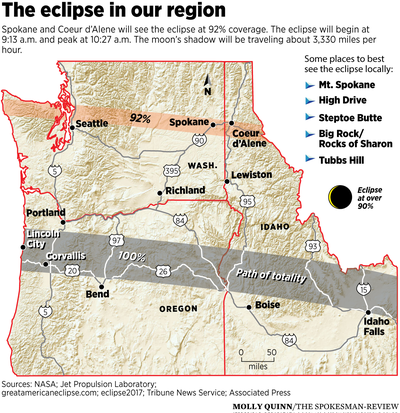Totality 2017: Final tips for your Monday eclipse viewing

A total solar eclipse such as the one that will shade the sun Monday is a relatively rare occurrence, especially when it crosses the continental U.S. from coast to coast, ensuring that millions of Americans will see the event.
The eclipse will start in the Pacific Ocean and reach the northern Oregon coast just after 9 a.m. on Monday.
There, it will reach totality just after 10:15 a.m., when the moon fully covers the face of the sun. Totality will be fleeting, lasting less than two minutes on the coast.
The event is a coincidence of nature that requires just the right set of circumstances to occur.
The moon needs to be on the near side of its slightly elliptical and tilted orbit around the Earth.
As the moon moves into its new phase, it is going to pass through or near the plane of the Earth’s rotation.
If the moon were on the far side of its orbit, then an annular eclipse occurs, which shows a ring of light around the moon’s silhouette.
In most of the moon’s orbits around the Earth, the moon’s shadow passes into space without touching Earth.
The path of totality, where the sun is completely obscured, is less than 70 miles wide.
A much broader area will see a partial solar eclipse. Spokane will see about 90 percent of the sun covered by the moon, enough to cause a distinct darkening of the sky.
“We will get a pretty good view in Spokane,” said Jim Picken, president of the Spokane Astronomical Society.
In Spokane, the eclipse starts at 9:13 a.m. and reaches maximum coverage of the sun at 10:27 a.m. The eclipse ends at 11:46 a.m.
The last total eclipse over the region was on Feb. 26, 1979, when the path of totality went through the southern half of Washington and far northern Oregon moving from west to east.
One of the magical ways to see a partial eclipse is through the light passing between leaves on the trees. They will provide a kind of lens mechanism, or camera obscura, to focus the shape of the eclipse on the ground.
A small hole put in the bottom of a box can focus the image of the sun onto a sidewalk or other surface. Some of the Spokane County libraries have invited children to join in the crafting the “cameras” for viewing.
Eclipse safety glasses are needed to look directly at the sun during an eclipse. Otherwise, serious damage can occur to retinas.
When the sun is not eclipsed, looking into it directly is virtually impossible. But with the darkening of part of its surface, it becomes possible to hold a gaze – and that is dangerous, authorities say.
One expert suggested that those who find themselves glassesless at the moment of eclipse make friends with someone who has the glasses, and ask for a quick look, maybe offering to take the person’s photo in exchange.
According to a report by the news site Vox, the moon’s shadow of totality will speed at 2,955 mph across the landscape after it reaches Oregon, the first place that totality makes landfall.
The speed is due to the angle of the sun in the morning. When the sun is overhead during the eclipse, the shadow will slow to 1,462 mph through Kentucky. The period of totality is longer, too.
After leaving Kentucky, the shadow will speed up again as the sun moves into the afternoon in the East before trailing off into the Atlantic Ocean.
Totality will last longer when the eclipse occurs closer to noon because the shadow is reaching Earth from a more overhead position.
Monday’s eclipse is the latest in a line of predictable eclipses from a pattern first discovered by the ancients.
The eclipse is part of the Saros 145 eclipse cycle. Each of the Saros eclipses occurs 18 years and 11 days apart. The next one will be in 2035.
Most eclipse watchers in the path of totality are already in place for Monday morning’s show, but in some cases, getting there wasn’t easy.
Central Oregon and the cities of Bend, Madras and Prineville have seen the worst of the pre-eclipse traffic jams.
A series of eclipse-related festivals were drawing tens of thousands of watchers last week, according to the Bend (Oregon) Bulletin.
“The Deschutes County Sheriff’s Office estimated about 30,000 people arrived in Central Oregon Thursday. About 37,000 are expected Friday, 44,000 Saturday, and 43,000 Sunday,” the Bulletin reported online on Friday.
“The vast majority of those people are expected to leave Monday and Tuesday,” the news story said.
Madras was expecting a crowd of 100,000.
The eclipse is also a hit on social media. Analytics from the Talkwalker website showed that more than 500,000 social posts were logged in a week ending Wednesday.
Authorities are warning people going into the path of totality to plan carefully with maps, extra food, water and a full tank of gas.
Taking pictures of an eclipse before totality can damage camera and phone equipment.
Paul Yost, of the Spokane Astronomical Society, said his best advice is to put down the camera and phone and simply enjoy the show – it is very short.
Stars and planets will come out in the darkened sky. Birds will fall silent and the temperature will drop quickly.
Since the shadow of totality is relatively small – no more than 70 miles wide – it pays to notice details away from the darkened sun. For instance, distant mountains may still be lit while you are in darkness.
“Look around,” he said.